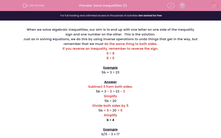When we solve algebraic inequalities, our aim is to end up with one letter on one side of the inequality sign and one number on the other. This is the solution.
Just as in solving equations, we do this by using inverse operations to undo things that get in the way, but remember that we must do the same thing to both sides.
The only difference when working with inequalities is that if you reverse an inequality, remember to reverse the sign.
5 < 8
8 > 5
Example 1
5b + 3 > 23
Answer
Subtract 3 from both sides.
5b + 3 - 3 > 23 - 3
Simplify
5b > 20
Divide both sides by 5
5b ÷ 5 > 20 ÷ 5
Simplify
b > 4
Example 2
b/5 - 3 ≤ 17
Answer
Add 3 to both sides.
b/5 - 3 + 3 ≤ 17 + 3
Simplify
b/5 ≤ 20
Multiply both sides by 5
b ÷ 5 x 5 ≤ 20 x 5
Simplify
b ≤ 100

Now for the hard one!
Example 3
Solve for a
5 - a ≥ 10
Answer
Add a to both sides.
5 - a + a ≥ 10 + a
Simplify
5 ≥ 10 + a
Subtract 10 from both sides.
5 -10 ≥ 10 - 10 + a
Simplify
-5 ≥ a
REVERSE and BE CAREFUL to change the SIGN DIRECTION
a ≤ -5
How do you feel about all those?

If you feel like the girl above, don't panic! Just take them one step at a time and write each step down on a piece of paper as you go along.
You can look back at this introduction at any point by clicking on the red help button on the screen.







